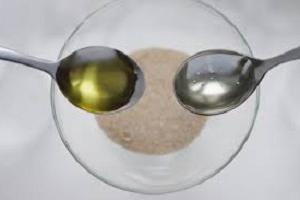If you spend a lot of time in the kitchen creating various culinary masterpieces, then, of course, you have often come across a situation where the measures of weight or volume in the manual for the preparation of a dish are not indicated correctly. An experienced hostess knows that laying the ingredients “by eye” can spoil the taste of your soup, pastries or the second, especially when it comes to products such as
sugar, salt and various spices. So, a
tablespoon of sugar. How many grams does this
volume measure hold
? It seems to be a simple question, but not everyone can give an answer to it. After all, until it comes to cooking, we never think that forks, spoons, knives, glasses and plates are mostly of different sizes, which depends not only on the preferences of the hostess, but also on the country of our residence. Somewhere traditionally they use small dishes, and somewhere, for example in America, portioned plates resemble giant serving dishes.
We answer a simple question: "How many grams of sugar are in a tablespoon?"
So, with the glasses, everything seems to be clear. When you see an instruction in a recipe to take, for example, 1 glass of flour, then most often we are talking about an ordinary faceted glass of 250 ml. If you are invited to put salt or vanillin “on the tip of a knife”, then this measure of volume is very arbitrary, but it makes it clear that you need to use these spices very, very carefully. But with spoons the situation is somewhat more complicated. Therefore, remember once and for all that the answer to the question of how many grams of sugar in a tablespoon will be the amount of 20 grams. And if you are used to pouring the product "with a slide", then in this case the weight will be all 25 grams.

Often, the recipes for the preparation of certain dishes indicate exactly the weight of the ingredients, which not everyone can measure. Of course, you can purchase special kitchen scales and verify the amount of required products to the nearest milligram, or you can just remember or print and hang on the wall a table that shows how many grams of sugar are
in a tablespoon, in a teaspoon, and also the weight of some products is given, corresponding to the indicated volumes (teaspoon and tablespoon).
Measures of weight and volume of commonly used products| The product's name | Amount in one teaspoon (“without slide” / “with slide”) | Amount in one tablespoon (“without slide” / “with slide”) |
| Water | 5/5 | 18/18 |
| Milk | 5/5 | 20/20 |
| Sunflower oil | 5/5 | 17/17 |
| Sugar | 5/7 | 20/25 |
| Salt | 7/10 | 25/30 |
| Flour | 4/5 | 10/15 |
| Rice | 5/8 | 15/20 |
How to apply the acquired knowledge?
Here is a good example. The Italian biscuit recipe states that you need to add 80 g to the dough. Sahara. Now you will have no doubt, because knowing how many grams of sugar in 1 tablespoon (20 g), you can safely measure out exactly 4 tablespoons, and your cookies will turn out exactly as it should: not cloying, but without lack of
granulated sugar. It’s so easy to use this information, now your dishes will turn out exactly as the authors of this or that recipe had in mind.
Calorie Sugar
It is known that the energy value of this product is 395 kcal per 100 g. Not too much, but keep in mind that you add sand not only to tea or coffee in sufficiently small quantities, but also to all kinds of pastries or when cooking jam, which already goes almost kilograms of this ingredient. Nevertheless, we already know how many grams of sugar are in a tablespoon, and based on this, it is possible to calculate the calorie content of this volume of the product - 80 kcal. That is, adding 4 tablespoons of sugar to cookies, you increase its calorie content by 320 kcal. Those who follow a diet, these data can be very helpful in calculating the daily energy value of the diet. Therefore, given that this product does not carry any nutritional value (sugar contains no vitamins, minerals, etc.), try to consume it as little as possible.